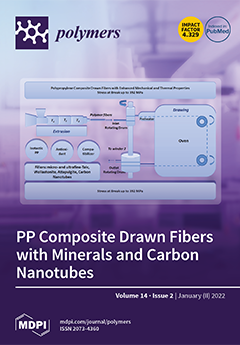Cationic organic pollutants (dyes and pesticides) are mainly hydrosoluble and easily contaminate water and create a serious problem for biotic and abiotic species. The elimination of these dangerous contaminants from water was accomplished by adsorption using cyclodextrin nanosponges. These nanosponges were elaborated by the cross-linking between 1,2,3,4-butanetetracarboxylic acid and β-cyclodextrin in the presence of poly(vinyl alcohol). Their physicochemical characteristics were characterized by gravimetry, acid-base titration, TGA,
13C NMR, ATR-FTIR, Raman, X-ray diffraction, and Stereomicroscopy. The BP5 nanosponges displayed 68.4% yield, 3.31 mmol/g COOH groups, 0.16 mmol/g β-CD content, 54.2% swelling, 97.0% PQ removal, 96.7% SO removal, and 98.3% MG removal for 25 mg/L of initial concentration. The pseudo-second-order model was suitable for kinetics using 180 min of contact time. Langmuir isotherm was suitable for isotherm with the maximum adsorption of 120.5, 92.6, and 64.9 mg/g for paraquat (PQ), safranin (SO), and malachite green (MG) adsorption, respectively. Finally, the reusability performance after five regeneration times reached 94.1%, 91.6%, and 94.6% for PQ, SO, and MG adsorption, respectively.
Full article






